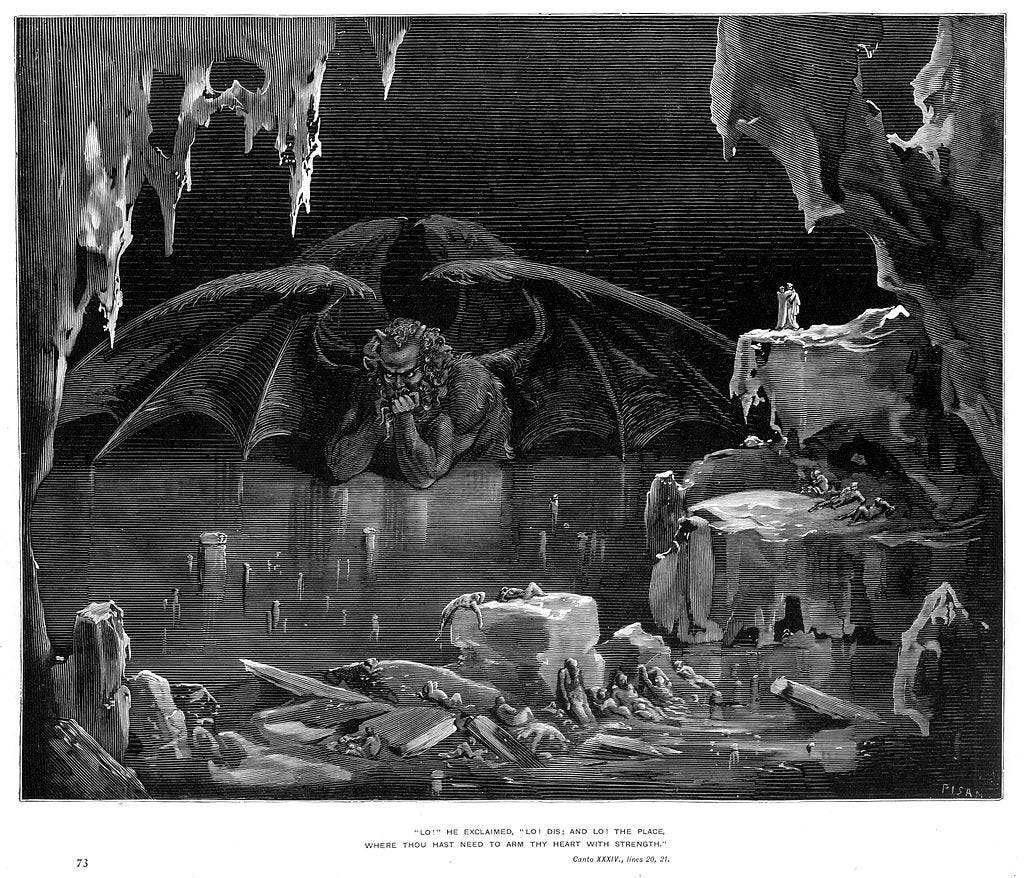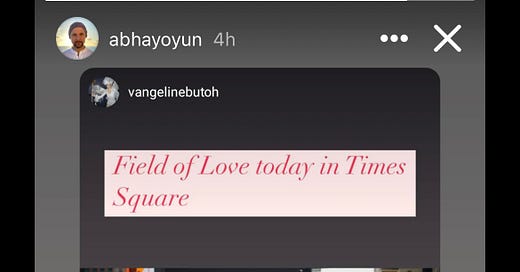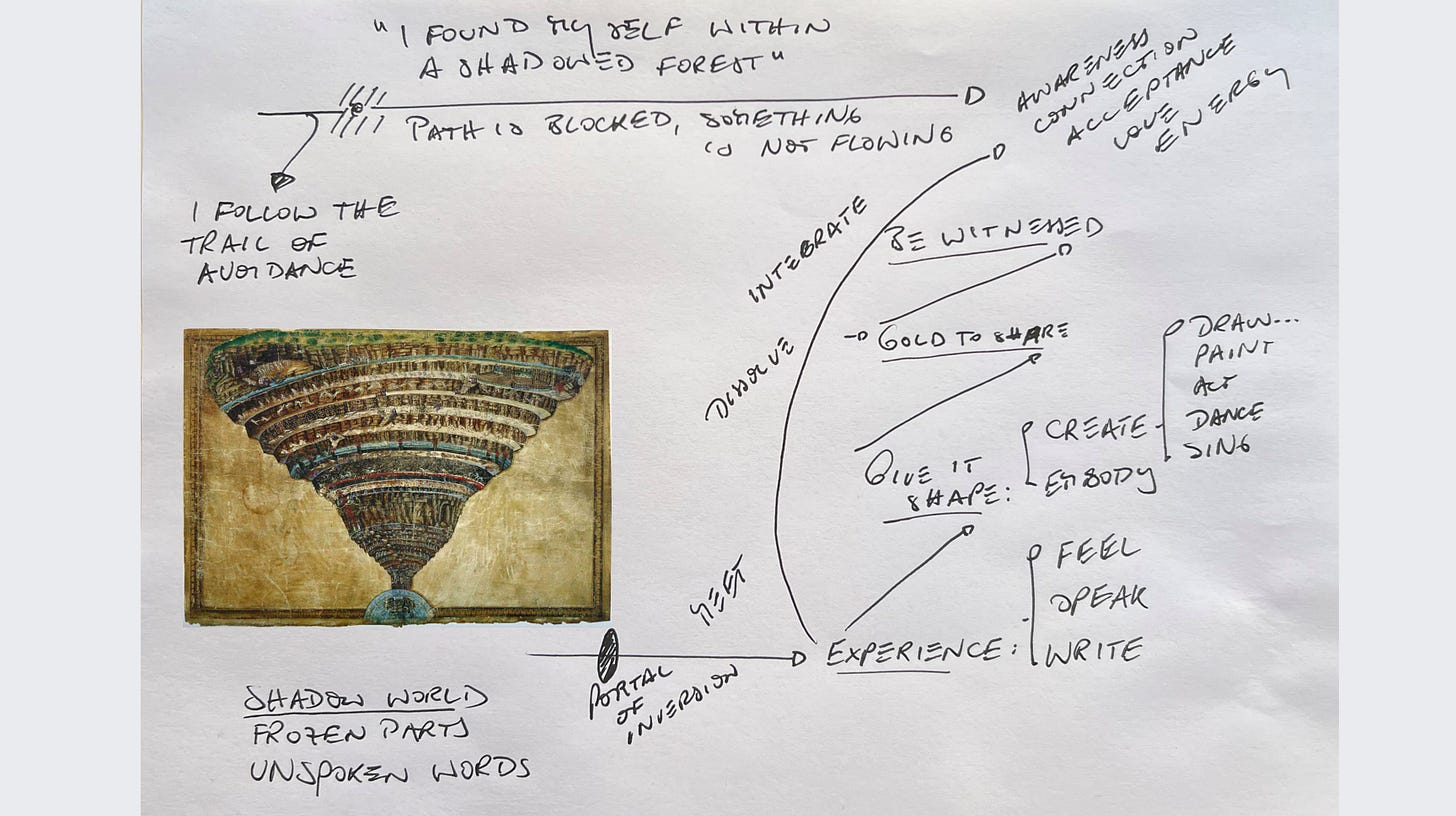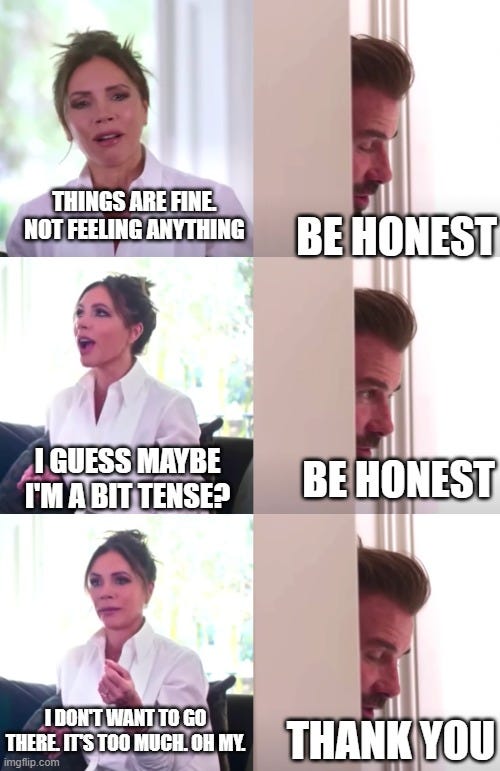Something changes when we are being witnessed. Maybe it’s like the observer effect: the mere presence of consciousness alters the situation.
Last weekend, I stood in Times Square in a shamanic-energy-dance circle. Like, an actual circle of flowers. On the floor. At the heart of Times Square. With a person banging the drum and a handful of people moving. The event had been organized by a wonderful dance teacher with her Siberian shaman friends visiting the city.
Depending on which part of me you ask, the whole thing seemed either earnest and precious or very cringe. Like, hyper-cringe. Mortifying.
Step into the circle. Move. Be weird. Be witnessed.
I felt an incredible amount of resistance but also an intuition to go. And at this point I try not to argue with my inner voice of clarity. So I joined this tiny dance to a lonely drum. A little vortex in the massive stream of traffic, tourists, and flashing lights.
Honestly, I felt wave after wave of embarrassment wash over me.
People stopped and stared. A few took pictures. Some laughed, others shrugged. We shared the corner with a guy and his big sign. Occasionally, he’d tell the crowd to repent and resist the devil. Accept Jesus as your savior. Times Square: still a place of free expression.
After a while, things started to feel unreal. I might as well have been a character in a video game. The feeling of humiliation faded.
People came and went. Faces of a faceless crowd. An infinite stream of flickering attention. Curiosity or judgment followed by a thirst for the next source of entertainment. I realized that it didn’t matter. They didn’t actually care. I was dealing with my experience, with my reaction. There were still jolts of anxiety and self-consciousness, but the bedrock sensation turned into a kind of equanimity.
People, traffic, sounds, my feelings . . . it was all one big stream, layered rhythms rising and fading.
Alright, you say. So what?
Well, I’ve bumped into this idea of the witness repeatedly recently. In dance, music, in coaching and healing spaces, and, yes, in writing.
I’ve been experimenting a lot with journaling.
What is the most powerful way to spend 15-20 minutes with pen and paper?
What is possible?
This brought me to intention and intensity.
While regular journaling is valuable, it can easily turn into a trap. It’s helpful to crystalize our stream of thoughts. Fixed on the page, the inner world can be examined. But the level of mind can be its own comfort zone. Stories turn into loops and journaling becomes an excuse to keep thinking and avoid feeling.
But I don’t want to passively record what happens to me.
I want to re-write my story.
I want to shape it.
I want to tap into more energy. I am looking for greater flow. I know there is a source of greater creative potential — and I want to connect with it.
I am looking for movement.
Movement on the page.
Movement in life.
Which is why I look for that which refuses to move, that which yearns to dissolve.

“Every man has . . . matters in his mind which he would not reveal even to his friends, but only to himself, and that in secret,” Fyodor Dostoevsky wrote in Notes from the Underground. “But there are other things which a man is afraid to tell even to himself.”
This may be the most important quote I know about journaling. If you can meet yourself with radical honesty, I don’t know if I have anything to teach you.
That which we are afraid to face even in the private space of our mind cannot move. It is frozen.
I am talking about the locked rooms of our inner house. Yellow tape on the doors. I am talking about barrels filled with emotions and memories labeled unsafe or undesirable.
You may know the symptoms.
Lack of energy, clarity, and creativity. Lack of flow. Maybe physical ailments like tension or back pain. You know the tired eyes behind the masks.
I always think of Dante and the beginning of his Divine Comedy. The poet finds himself lost in a dark forest.
When I had journeyed half of our life’s way,
I found myself within a shadowed forest,
for I had lost the path that does not stray. — Canto I, Columbia’s Digital Dante
“I cannot clearly say how I had entered the wood; I was so full of sleep just at the point where I abandoned the true path.” He awakens to his situation. Add a smartphone and some singing bowls and that’s kind of how I feel.
Dante can see the sun which “which serves to lead men straight along all roads,” but his path is blocked by three beasts. He needs help. Roman poet Virgil appears to guide him on “another path” out of the “savage wilderness.”
It’s a pilgrimage into the realm of shadows. Every circle of hell offers Dante a chance to develop greater awareness of the human condition. He watches souls tortured in infinite loops and of course gets most “triggered” when he detects his own flaws in them.
At the very bottom, Dante and Virgil find Satan, the “emperor of the despondent kingdom,” in a frozen lake.
It is a place beyond language. “I grew faint and frozen then,” Dante reports in Canto 34. “I cannot write it: all words would fall far short of what it was.”
What a powerful image.
It’s the place farthest from the light, devoid of motion and warmth. Frozen. The energy of death. Satan in Doré’s illustration seems to be stewing in resentment. Stuck in his commitment to a futile rebellion against creation. A denial of love and forgiveness.
Dante’s pilgrimage is a microcosm of how I think about the potential of journaling. To find our path forward and upward, we must occasionally make a detour.
If we find our way blocked, it’s time to follow the trail of shadow words and enter our maze.
We must visit the spaces we avoid and meet the parts of ourselves that have been judged, disowned, and abandoned. We must meet what — who — is frozen in time.
Signs I look for:
Inaction on a goal, change, or decision. Not doing the thing.
Lack of clarity. Unsure what “the thing” even is.
Feeling disconnected:
From emotions, inner truth, and guidance;
From flow, energy, and creativity;
From the present moment.
Feeling the weight of holding on to the past — to ideas, projects, relationships, or physical matter. Is there space for something new to emerge?
Then I look for the trail. . . What have I been avoiding? What am I hesitant to even think? What words are stuck in my throat? I try to get out of the way and let the pen tell the story.
All it takes is pen, paper, and privacy. That’s the portal. (I know that if another person is in the same room, some amount of self-censorship of the authentic experience will happen.)
I seek to meet what I find with curiosity and warmth. If possible, I play with increasing the intensity of experience. This can be as simple as saying the words out loud after writing them (hearing the thought → letting it be written → then consciously speaking it out loud).
Afterward, what is frozen may want to move. How could I give it shape? What forms of creative expression are possible?
I believe there is gold to be found in the shadow. There is art, wisdom, and energy yearning to be shared. That doesn’t mean going public, let alone stepping into Times Square. It can be as simple as a conversation with one person we trust. But something changes when we are being witnessed.
Meet what feels cold and dead with light and heat.
Let it dissolve. Let it move.
Bring it back to life.
Meet it, experience it, give it shape, express it, be witnessed — and let it go.
Here’s the tricky part. I’ve learned a lot about going into shadow. I am still figuring out what comes next.
It all seems to boil down to love and acceptance: “Is it okay to be me?” Am I okay with all that I am? Is there space in this world for everything I am? Big questions once you get a glimpse of the many rooms in your house. Important questions, too. If we can’t accept all that we are, can we accept others fully?
That path leads away from the page. It is not a path of reading, writing, or thinking. It is a path of direct experience. I find that the frozen often exists in a realm beyond language and I think the same is true when we look for an answer or way to express it.
That’s what brought me to these odd shamanic spaces: the path upward is energetic. It’s about connection and capacity, capacity to love and forgive what weighs us down. It’s not about finding objective truth. Or at least it has not been that way for me.
I couldn’t quite put my fingers on it when I wrote about writer-director Taylor Sheridan, but the connection between creativity and energy now seems obvious. It’s all people, places, practices, and intention — and how those translate into action.
For me right now it’s simple stuff: meditation, walks among trees, the room of intimate conversation. I am building a little stack of tools and frameworks — breath, sound, tapping, TRE, Internal Family Systems. But nothing has been more profound than embodied creative practices — vocalization and free form dance above all.
I like to write (and talk), but language is just a map. It can point you toward a realm of possibility, but it is no substitute for walking.
Journaling works best when it feels least like writing.
It works best when it turns into a channel, when it feels like movement and connection to something deeper, greater, stranger, and more powerful than the conscious mind.
It works best when it creates more aliveness. Sometimes that leads into darkness and involves tears. Other times it happens in the bright lights of the Big Apple’s flashing billboards.
— Frederik
Prompts I’ve found helpful recently:
Nobody must ever know that I [thought / said / did / desired] . . . [x].
What important moment(s) explain where I am that I would never share (that I would never put on my bio/CV)? What am I hiding and why?
If I truly and deeply loved myself, would I . . . do this / keep myself from doing this / let this be done to me / accept this in my life? What can I find out about what is behind what I don’t like about my life?
Try the Sarno method. Brain dump every big stressor in your life (past, present, character traits). I don’t know about you, but chances are that you’re censoring how you really feel about these. Notice that. Where do you hold yourself back?
Gun to the head: imagine you woke up in the middle of the night with a gun to your head. You hear a voice: Tell me more about this . . . tell me the whole story. Everything. Be honest!
Imagine that every time you hold back, every time you stumble, every time you police your language and make it nice and polite, imagine that the voice knows. Imagine it thundering: Tell me the truth! Tell me your truth, the truth as only you experience it right now.
Be as specific as you can. Write it down. Say it out loud. Keep going until you find what is truly frozen. That can turn into a source of motion, wisdom, and energy. It might not happen in a short journaling session (though I hope you can release some of the pain and tension). But this is your access point.
You can do the same exercise with your life’s story. Say your “elevator pitch” or imagine you gave a TED talk about your life. Then bring in the voice.







Did something similar in BOSTON. I ended up dancing around. I lost my inhibition and of course the $20 bucks they wanted in the end. But my wife got some good pics, I got a memory maker, and I made friends with some random guy from Heidelberg.
Stupendous